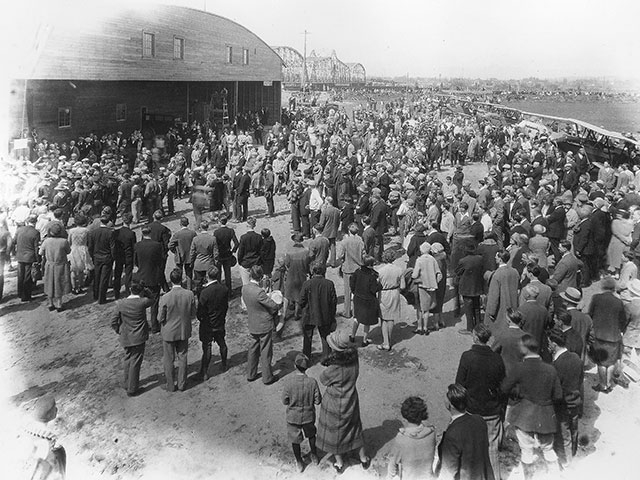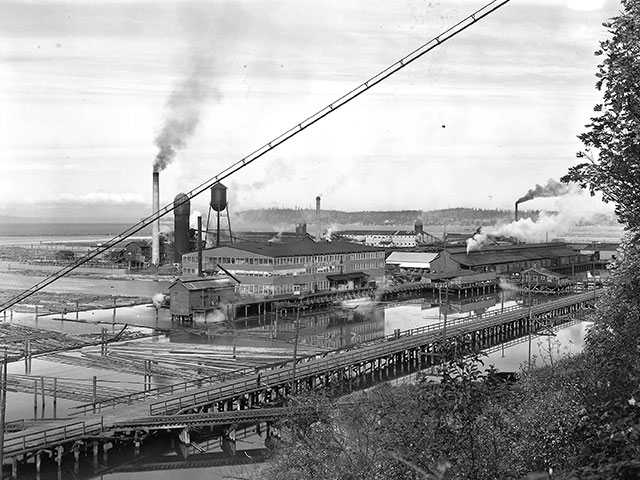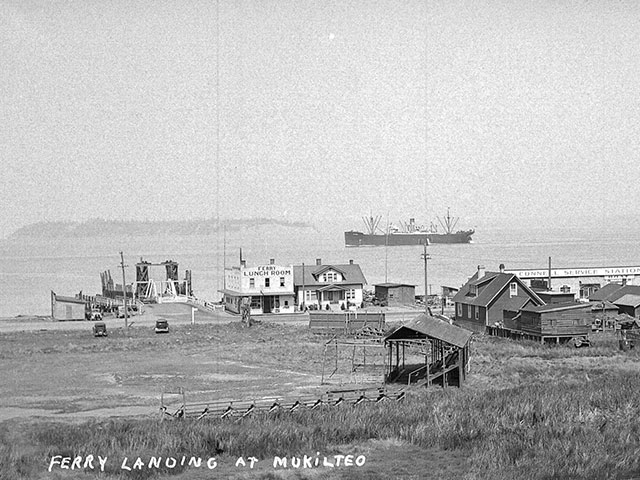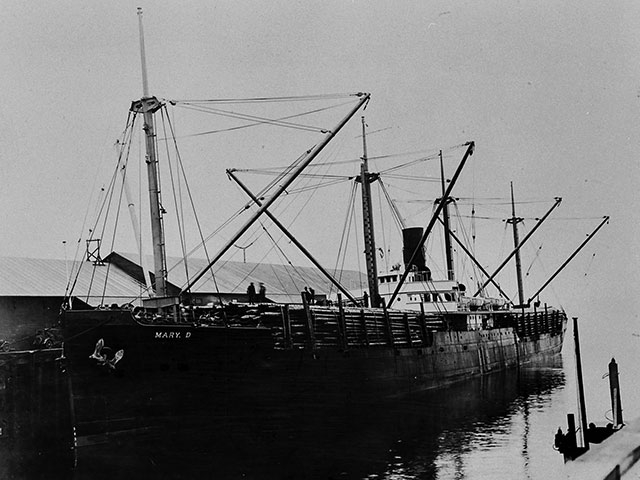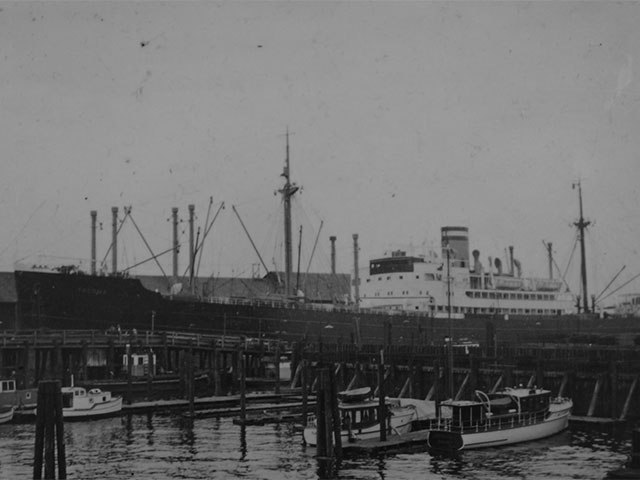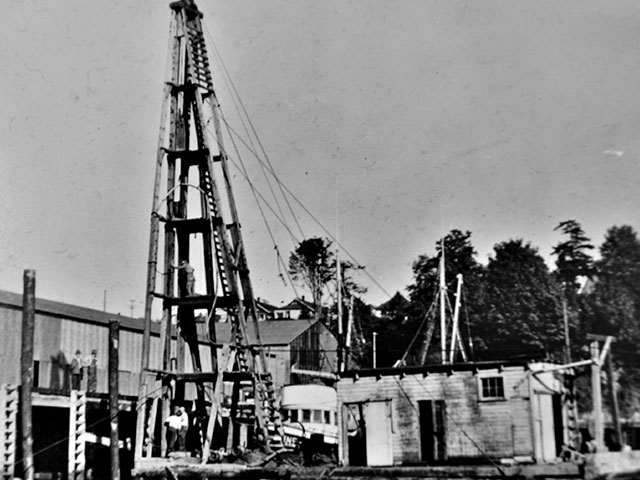1920 - 1929
Timeline
1920-1921
The country experiences a post-World War I slump.
1920
The Port Commission, responding to a request from a private ferry operator based in Clinton, on Whidbey Island, and others, decides to build a ferry landing on the tidelands it controls in Mukilteo. The Commission must first ask permission from the county, which gives its blessing. Ferries are later run there by the Puget Sound Navigation Company (the Black Ball Line) and eventually, in 1951, by the Washington State Ferries system — which provide service at the site today.
1923
A magnitude 7.9 earthquake strikes Japan; Everett’s timber business booms as it exports lumber products to the stricken Pacific island nation.
1923
The ornate, Gothic-style Weyerhaeuser Office Building is built at the site of the company’s first Everett plant, Mill A (the site of today’s South Terminal shipping facility). The building’s hemlock interior woodwork and fir walls showcase the company’s local wood products.
1925
The Everett Yacht Club asks about berthing facilities near its location on the south waterfront; the Port responds that it has “insufficient funds for carrying the brunt of such improvement and has no means of financing same at this time.” However, the Port notes, they’re “willing to cooperate with the Yacht Club or others in any way possible to further the aims of a berthing place for small water craft,” giving an early hint at a commitment to providing public marina facilities.
1926
The iconic 60,000-square-foot North Coast Casket Company Building (later known as the Collins Building), opens. The three-story, post and beam structure is built by the neighboring Hulbert Lumber Company as a casketmaking factory; the casket shells are built from the mill’s scrap and end material. The building’s most prominent visual feature is three horizontal bands of divided-light wood-sash windows that wrap nearly around the building’s perimeter (except for its northwestern corner), with one band on each floor. The extensive windows provide plentiful natural light.
1926
The Everett Flour Mill Company is demolished. It had operated at what’s now 25th Street and West Marine View Drive from 1901 to 1921. (Its demise makes way for the massive Puget Sound Pulp and Timber Company to take over the site in the next decade, followed by Soundview Paper Company, Scott Paper Company, and the Kimberly-Clark plant after that.)
1927
The Port creates a special fund to purchase Tract M — near Piers 1 and 2 and the Everett Yacht Club — from the Everett Improvement Company for $19,000. The Port begins making improvements and the tract serves as home base for the commercial fishing fleet, early pleasure boats, and later home to the Everett Boathouse at the foot of Hewitt Avenue.
1928
A fire consumes five dry kilns and several million shingles at the mighty Jamison Mill Company, which had opened on the north bayfront in 1913 and produced over a million shingles a day by 1926. The company rebuilt and was a formidable force into the 1950s.
1928
The Everett Airport, also known as Ebey Island Airport, is dedicated. The site, a project of the Port of Everett and Commercial Air Transport, is the first Snohomish County airport. (The airport, no longer in existence, was located near today’s Smith Island, off Highway 529 between Everett and Marysville.)
1928
Puget Sound fishermen purchase the Everett Packing Company and organize the Fishermen’s Packing Corporation — a cooperative to provide canning services for local fishermen. In time, the co-op would grow to some 225 members.
1929
The massive Clough-Hartley shingle mill on the bayfront at 18th Street — considered the largest of its kind in the world when it opened in 1907 — closes its doors. In 1916, Clough-Hartley's daily shingle production was said to be 1.5 million, but by 1928 Edward Hartley reportedly said he knew of at least four bayfront cedar mills that had been operating at a loss since 1923. Reasons cited included obsolete machinery, competition from composition roofing and difficulty in getting enough quality red cedar — a mill staple.
1929
After a special public vote the previous year, the Port acquires the 14th Street Dock and the jetty (later dubbed Jetty Island), as well as land at Preston Point, from the Everett Improvement Company. The move gives the Port control of a central business district and keeps alive hopes to close off the Snohomish River between the jetty and Preston Point to alleviate the need for harbor dredging, as well as create a freshwater harbor. The jetty also offers a site for industrial use and potential development projects.
Establishing the Port in Earnest
In 1920 and 1921, the region struggled with the effects of a national economic downturn in the transition from a wartime to a peacetime economy following World War I — but in 1923, an earthquake in a country far across the Pacific Ocean got the fledgling Port’s lumber export business rolling. That year, the Great Kanto earthquake, with an estimated Richter magnitude of 7.9, struck Japan’s Tokyo-Yokohama metropolitan area. The death toll was estimated to have exceeded 140,000; more than half of the brick buildings and one-tenth of the reinforced concrete structures in the region collapsed. Japan needed to rebuild, and Everett’s lumber mills were happy to oblige, kick-starting the Port’s timber export business.
While the early waterfront had included a diversity of industries — from the Puget Sound Wire Nail and Steel Company nail works to timber-based industries to a flour mill — by the 1920s the lumber and shingle industry was firmly the main driver of Everett’s economy. Everett packing businesses were busy as well. In the 1920s, American Packing Company and Everett Packing Company (which had taken over the old nail works plant on Pier 1) were located along the south bayfront on the piers near the Tract M home of the fishing fleet. In 1928 alone, the fish canneries processed 69,000 cases of salmon. That same year, local fishermen organized Fishermen’s Packing Corporation and bought Everett Packing Company, putting themselves at the helm of not just their boats, but their canning operations, too.
In 1928, in a special public vote, the 14th Street Dock area, the jetty and land at Preston Point were approved to be added to the Port’s holdings. (They were formally added in 1929.) The moves gave the Port control over properties it would not only have for decades to come, but would also prove extremely useful. The 14th Street Dock gave the Port operational control of a central business hub (as well as site for later marina activities); the jetty would continuously prove its worth as a spot to deposit dredged sediments, offer log and watercraft storage (and later, recreation), and — in combination with Preston Point — create a method to potentially close off the silty Snohomish River from the harbor.
The rest of the early waterfront infrastructure was also well in place. By the middle of the previous decade Norton Avenue had been constructed on wooden pilings west of the railroad tracks. (This main north-south artery would decades later be known as West Marine View Drive.) Pier 2 at the foot of Hewitt Avenue (also known as City Dock — still best known as the site of the 1916 Everett Massacre) was the major connecting point for both passenger and commercial travel, as well as a hub through the 1920s for the “Mosquito Fleet” (the hundreds of steamships that carried early travelers throughout the Puget Sound region beginning around the 1850s) on Port Gardner Bay.
And after repeated requests from a private ferry operator and area residents, in 1920 the Port built a ferry landing at Mukilteo for boats running between there and the town of Clinton on Whidbey Island to the west. The landing, while rebuilt many times over, still provides ferry service today through the Washington State Ferries system.



